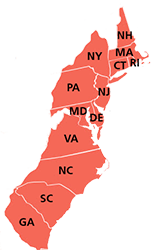The Middle Colonies
The Dutch, New Netherland, and New Jersey
 The Middle colonies consisted of mountains, fertile farming land, and coastal lowlands that contained harbors and wide, deep rivers. Natural resources in the Middle colonies were abundant, leading to the development of numerous small manufacturing industries. The Dutch were the first Europeans to colonize the Middle colonies. In this interactivity, explore the Dutch colonization of New Netherland and the colonization of New Jersey. Click the player button to begin.
The Middle colonies consisted of mountains, fertile farming land, and coastal lowlands that contained harbors and wide, deep rivers. Natural resources in the Middle colonies were abundant, leading to the development of numerous small manufacturing industries. The Dutch were the first Europeans to colonize the Middle colonies. In this interactivity, explore the Dutch colonization of New Netherland and the colonization of New Jersey. Click the player button to begin.
View a printable version of the interactivity.
![]() As you explore this topic, fill out the Quick Facts about the Colonies Template to help you organize your ideas. You will need to reference this document again in the module assessment.
As you explore this topic, fill out the Quick Facts about the Colonies Template to help you organize your ideas. You will need to reference this document again in the module assessment.
The Quakers, Pennsylvania, and Delaware
 Looking for religious freedom, William Penn chose to create a colony in Pennsylvania that adhered to the principles of the Quakers. These same principles attracted many settlers from a variety of different backgrounds. Unlike the New England and Southern colonies, Pennsylvania had a friendly relationship with the American Indians. In this interactivity, investigate the Quakers and the colonization of both Pennsylvania and Delaware. Click the player button to begin.
Looking for religious freedom, William Penn chose to create a colony in Pennsylvania that adhered to the principles of the Quakers. These same principles attracted many settlers from a variety of different backgrounds. Unlike the New England and Southern colonies, Pennsylvania had a friendly relationship with the American Indians. In this interactivity, investigate the Quakers and the colonization of both Pennsylvania and Delaware. Click the player button to begin.
View a printable version of the interactivity.
 Thirteen Colonies
Thirteen Colonies
Other colonies in America were colonized during the 1600s and 1700s. Maryland was colonized in 1632. George Calvert, the first Lord Baltimore, received a grant for this colony from King Charles I. Calvert’s son Cecil named the colony Maryland, for Queen Henrietta Maria, who was Charles’s Queen. The colony of Maryland was created to be a haven or safe place for English Catholics.
In 1663, King Charles II gave supporters the land between Virginia, and the Spanish controlled Florida. This land became the colonies of North and South Carolina.
In 1732, Georgia became a colony. Philanthropist James Oglethorpe received a charter to create a colony meant for anyone imprisoned for debt. The colony was named Georgia after King George II. After the colonization of Georgia, America consisted of thirteen colonies.
Economy of the Middle Colonies
 The Middle colonies faced the challenge of attracting settlers. In response to advertisements throughout Europe, a rich diversity of settlers eventually came to the Middle colonies. This rich diversity of people brought with them many skills in crafting and farming. The strong middle class of the Middle colonies encouraged trade, and Philadelphia grew to be the second largest city in the British Empire. In this interactivity, learn about the economy of the Middle colonies. Click the player button to begin.
The Middle colonies faced the challenge of attracting settlers. In response to advertisements throughout Europe, a rich diversity of settlers eventually came to the Middle colonies. This rich diversity of people brought with them many skills in crafting and farming. The strong middle class of the Middle colonies encouraged trade, and Philadelphia grew to be the second largest city in the British Empire. In this interactivity, learn about the economy of the Middle colonies. Click the player button to begin.
View a printable version of the interactivity.
Diversity of the Middle Colonies

Population of the British Colonies in America Before 1776, Robert V. Wells
Colonial Diversity, 1775
Over time, the Middle and New England colonies would observe an increase in the diversity of their colonists. The Germans and the Scots-Irish were the largest immigrant groups. Most of the Germans came to the colonies seeking economic opportunity or religious freedom. The Scots-Irish traveled to the colonies as families. Most of the Scots-Irish settled in frontier areas of western Pennsylvania, and often had conflicts with the American Indians. Many other ethnic groups traveled to the colonies. View the graph above to gain a better understanding of Colonial diversity.
The Middle Colonies Review
![]()
 Now that you have learned about the Middle colonies, complete this activity to test your knowledge. In this interactivity, read the question(s) and select the correct answer(s). Click the player button to get started.
Now that you have learned about the Middle colonies, complete this activity to test your knowledge. In this interactivity, read the question(s) and select the correct answer(s). Click the player button to get started.